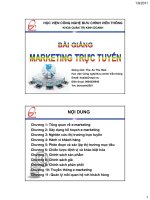Bài giảng MARKETING MANAGEMENT LECTURE NOTES: chap 2 developing marketing strategy and plan
Bạn đang xem bản rút gọn của tài liệu. Xem và tải ngay bản đầy đủ của tài liệu tại đây (508.81 KB, 8 trang )
1/11/2018
1
2
Developing Marketing
Strategies and Plans
Phases of Value Creation and
Delivery
Choosing the value
Providing the value
Communicating the value
Copyright © 2011 Pearson Education, Inc. Publishing as Prentice Hall
2-2
What is the Value Chain?
The value chain is a tool for identifying was
to create more customer value because
every firm is a synthesis of primary and
support activities performed to design,
produce, market, deliver, and support its
product.
Copyright © 2011 Pearson Education, Inc. Publishing as Prentice Hall
2-3
1
1/11/2018
The Value Chain
2-4
Copyright © 2009 Pearson Education, Inc. Publishing as Prentice Hall
Core Business Processes
Market-sensing process
New-offering realization process
Customer acquisition process
Customer relationship management process
Fulfillment management process
Copyright © 2011 Pearson Education, Inc. Publishing as Prentice Hall
2-5
Characteristics of
Core Competencies
A source of competitive advantage
Applications in a wide variety of markets
Difficult to imitate
Copyright © 2011 Pearson Education, Inc. Publishing as Prentice Hall
2-6
2
1/11/2018
What is Holistic Marketing?
Holistic marketing sees itself as integrating
the value exploration, value creation, and
value delivery activities with the purpose of
building long-term, mutually satisfying
relationships and co-prosperity among key
stakeholders.
Copyright © 2011 Pearson Education, Inc. Publishing as Prentice Hall
2-7
Figure 2.1 The Strategic Planning,
Implementation, and
Control Processes
Copyright © 2011 Pearson Education, Inc. Publishing as Prentice Hall
2-8
What is a Marketing Plan?
A marketing plan is the
central instrument for
directing and coordinating
the marketing effort.
It operates at a strategic and tactical level.
Copyright © 2011 Pearson Education, Inc. Publishing as Prentice Hall
2-9
3
1/11/2018
Levels of a Marketing Plan
Strategic
Target marketing
decisions
Value proposition
Analysis of
marketing
opportunities
Tactical
Product features
Promotion
Merchandising
Pricing
Sales channels
Service
Copyright © 2011 Pearson Education, Inc. Publishing as Prentice Hall
2-10
Corporate Headquarters’
Planning Activities
Define the corporate mission
Establish strategic business units (SBUs)
Assign resources to each SBU
Assess growth opportunities
Copyright © 2011 Pearson Education, Inc. Publishing as Prentice Hall
2-11
Good Mission Statements
Focus on limited number of goals
Stress major policies and values
Define major competitive spheres
Take a long-term view
Short, memorable, meaningful
2-12
Copyright © 2009 Pearson Education, Inc. Publishing as Prentice Hall
4
1/11/2018
Copyright © 2011 Pearson Education, Inc. Publishing as Prentice Hall
2-13
Product Orientation vs.
Market Orientation
Company
Product
Market
Missouri-Pacific
Railroad
We run a railroad
We are a peopleand-goods mover
Xerox
We make copying
equipment
We improve office
productivity
Standard Oil
We sell gasoline
We supply energy
Columbia Pictures
We make movies
We entertain
people
Copyright © 2011 Pearson Education, Inc. Publishing as Prentice Hall
2-14
Characteristics of SBUs
It is a single business or collection of related
businesses
It has its own set of competitors
It has a leader responsible for strategic
planning and profitability
Copyright © 2011 Pearson Education, Inc. Publishing as Prentice Hall
2-15
5
1/11/2018
Figure 2.2 The Strategic Planning
Gap
Copyright © 2011 Pearson Education, Inc. Publishing as Prentice Hall
2-16
Intensive Growth Strategies
Ansoff’s Product-Market Expansion Grid
2-17
Copyright © 2009 Pearson Education, Inc. Publishing as Prentice Hall
Figure 2.3 The Business Unit
Strategic Planning Process
Copyright © 2011 Pearson Education, Inc. Publishing as Prentice Hall
2-18
6
1/11/2018
SWOT Analysis
Strengths
Weaknesses
Opportunities
Threats
2-19
Copyright © 2009 Pearson Education, Inc. Publishing as Prentice Hall
Market Opportunity Analysis
(MOA)
Can the benefits involved in the opportunity be articulated
convincingly to a defined target market?
Can the target market be located and reached with costeffective media and trade channels?
Does the company possess or have access to the critical
capabilities and resources needed to deliver the customer
benefits?
Can the company deliver the benefits better than any actual or
potential competitors?
Will the financial rate of return meet or exceed the company’s
required threshold for investment?
Copyright © 2011 Pearson Education, Inc. Publishing as Prentice Hall
2-20
Figure 2.4
Opportunity and Threat Matrices
Copyright © 2011 Pearson Education, Inc. Publishing as Prentice Hall
2-21
7
1/11/2018
Porter’s Generic Strategies
Overall Cost Leadership
Differentiation
Focus
2-22
Copyright © 2009 Pearson Education, Inc. Publishing as Prentice Hall
Marketing Plan Contents
Executive summary
Table of contents
Situation analysis
Marketing strategy
Financial projections
Implementation controls
Copyright © 2011 Pearson Education, Inc. Publishing as Prentice Hall
2-23
8









